Cables stretch, housings compress, and in today’s era of modern bikes, exact cable tension to both brake and shifting performance are crucial to having a perfectly tuned bicycle. Mountain bikes have built-in adjusters on shifters and mechanical brake levers. It used to be there was some redundancy. The rear derailleur had an adjuster at both the shift lever and the derailleur. Then a few years ago, the adjuster at the derailleur disappeared and it was only found on the lever, presenting a challenge when trying to combine mountain and road components.
It used to be all road bikes had an adjuster at the down tube shift boss or threaded stop (or head tube depending on brand’s locations). Then external cable stops disappeared as carbon fashion dictated that all cables should be hidden internally. This left road bikes without a convenient, frame mounted, method to tension shift cables. It also left front derailleur adjustments to chance. While it was possible to dial in cable tension via anchoring the front derailleur cable with the lower limit screw turned in a bit and then backing out the limit once the cable was attached, thereby tensioning the cable enough for the front indexing to work properly, it was a bit of a trial-and-error method. Much easier to adjust Campy front shifting than it was Shimano or SRAM. It was much easier to dial in front shifting if there was an in-line adjuster.
For older Shimano shifters, one of the Ritchey designed, now a Jagwire product,
Rocket STI adjusters worked great for both front and rear shifting. The adjuster fit into the lever body’s cable stop and allowed easy mid-ride adjustments. The only problem was that during constant shifting, rattling, turning…the adjuster could thread itself in just enough over a period of time that shifting performance could suffer. Easy enough to keep in check by making small adjustments when shifting was felt to falter.
Then Shimano followed suit with Campy and SRAM and ran their housings under the bar tape. Plan B.
Mid-cable housing adjusters. These handy things have been around since the early days of mountain bikes when riders chose to run drop bars on their bikes and lost the brake lever’s barrel adjuster. At first, these in-line adjusters came from the motorcycle side and required special ferrules that perfectly fit the oversized ends. Eventually, in-line adjusters became available from Jagwire that fit with standard bicycle ferrules.
I like to put together bikes that incorporate road and mountain components. Sometimes you want the low gears that mountain bikes have, but you want the comfortable, multi-position bars from road bikes. In cases like these and if the frame has no threaded cable stops, there isn’t any way to properly tune index shifting or take out cable stretch on the brakes. However, if you have a Black Mountain Cycles frame, I got you covered. And depending on the part, I have ways to add in an adjuster through the use of a certain part or an in-line adjuster. This is the stuff that’s fun to figure out how to make adjustments not only possible, but easy. Here’s some ways to ensure you can tension your cables.
Here is a Tektro CR710 canti brake that has a threaded adjuster built into the straddle cable.
This is the Jagwire Rocket II adjuster fit into a Sturmey-Archer 3-speed shifter. This adjuster also fits into older Shimano STI shifters with exposed cables.
The Avid BB7 brake caliper doesn’t have a built in adjuster. I used a Dia-Compe threaded adjuster for this application. The cable tension keeps it in place and this is really only for micro adjustments.
These are two in-line adjusters that came from the motorcycle side. These actually require oversized ferrules (or oversized housing) to be 100% proper with the smaller 5mm housing.
This custom in-line adjuster is made by Charlie Cunningham to work with standard 5mm housing.
The Paul Mini-Moto has a built-in adjuster at the top of the lead pipe. Very nice detail.
On my cross frames, I incorporated an adjuster behind the seat tube for front derailleur cable adjustments.
When I use a Shimano road shifter (bar-con or STI) with a Shimano Shadow type rear derailleur, I use one of the Jagwire Rocket II adjusters fit into the cable stop on the derailleur.
(What’s playing: KWMR Coast Highway Blues)

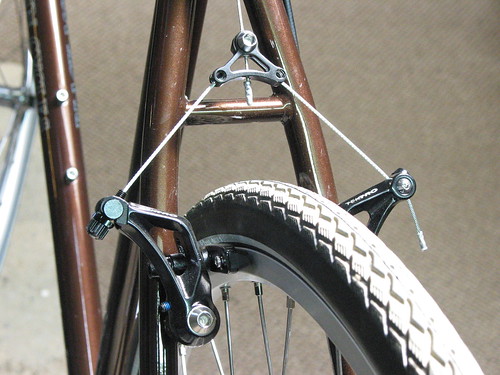
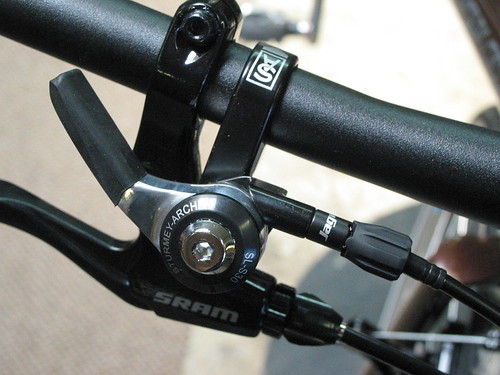
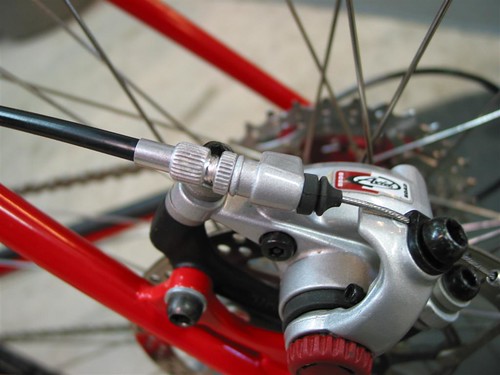
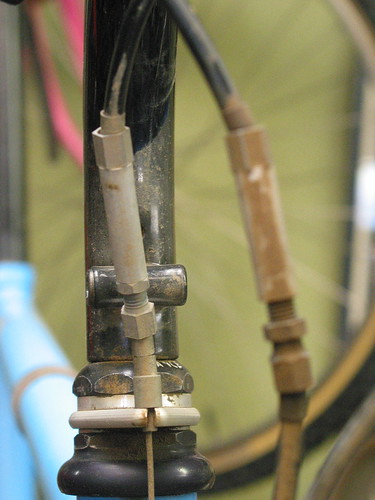
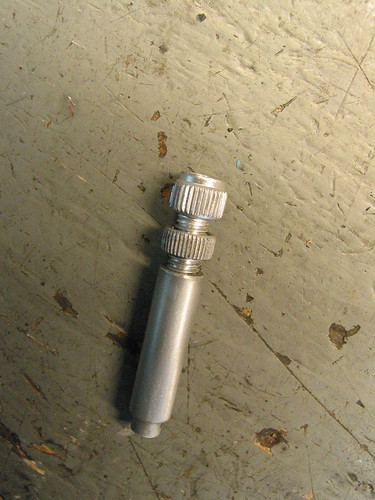
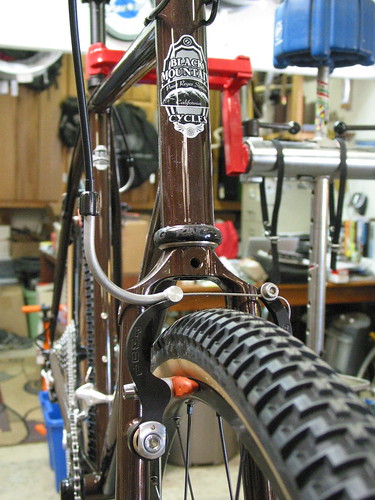
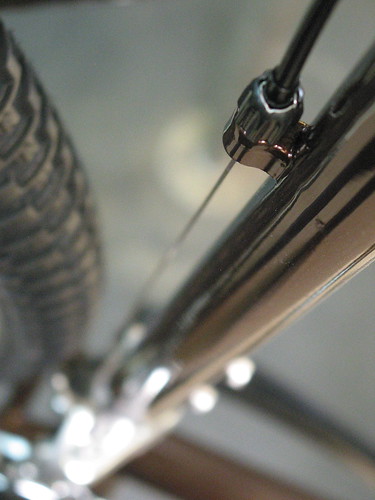

A question about the first adjuster, which I've been wondering about since I became aware of the design:
Doesn't putting the adjuster on the straddle cable mean that you decrease the mechanical advantage of the brakes when you add tension to the cable? Does this effect braking performance at all or is the change so slight as to be of no practical importance? Seems like the adjuster ought to be attached to the yoke instead of the brake arm.
Theoretically, it would change, but it's likely so small, it's negligible. That adjuster is mainly to compensate for pad wear. If one is backing out adjusters so far, to the point that the brake's mechanical performance is changed, something is amiss. Adjusters should be used only for small adjustments that need to be made conveniently.
Is it easier to adjust the jagwire barrel adjuster on a Shimano rear dérailleur than the one that usually comes stock on Shimano derailleurs?
The new Shimano shadow type derailleurs (as shown in the photo) do not have barrel adjusters. This Jagwire adjuster fits into the cable stop on the derailleur. If you have a Shimano derailleur that has the traditional type body, it already had an adjuster.
Are the Shimano Shadow derailleurs shown here the older 9 speed type? It was my understanding that the newer Dyna-Sys 10 speed derailleurs won't work right with road shifters due to a different cable pull ratio.
BluesDawg – yes, that is a 9-speed XT rear derailleur. And correct, the Shimano Dyna-Sys 10s rear derailleur is not compatible with Shimano's road (STI or bar-con) shifters.